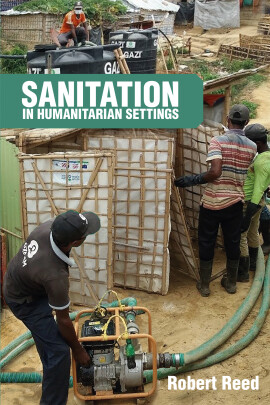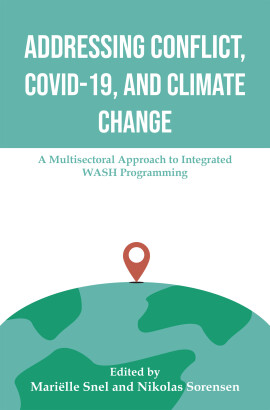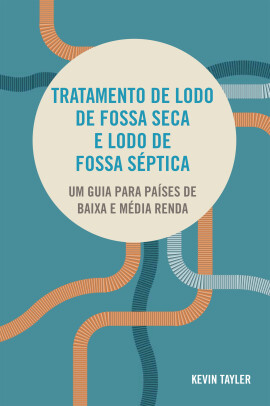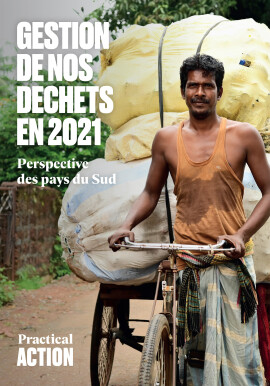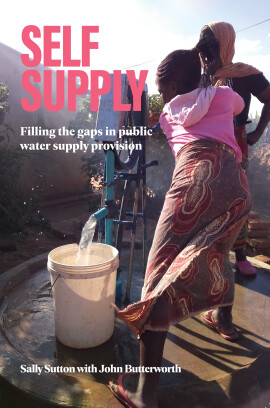
Self-Supply
Filling the gaps in public water supply provision
Sally Sutton, John Butterworth
While governments and development partners focus on improving community and utility-managed water supplies to ensure access for all, hundreds of millions of people are taking actions to supply their own water. In the WASH sector household investment in construction and improvement of facilities is widely employed in sanitation but in water similar efforts are ignored. Recognition of the contribution of self-supply towards universal access to water and its full potential, is hampered by a lack of data, analysis and guidance.
This well-reasoned source book highlights the magnitude of the contribution of self-supply to urban and rural water provision world-wide, and the gains that are possible when governments recognise and support household-led supply development and up-grading. With limited public finances in low- (and many middle-) income countries, self-supply can fill gaps in public provision, especially amongst low-density rural populations. The book focuses on sub-Saharan Africa as the region with the greatest predicted shortfall in achieving the 2030 Sustainable Development Goal for water.
Household supplies can be created, or accelerated to basic or safely managed levels, through approaches that build on the investment and actions of families, with the availability of technology options and cost-effective support from the private and public sectors. The role of self-supply needs greater recognition and a change in mindset of governments, development partners and practitioners if water services are to be extended to all and no-one is to be left behind.
Sally Sutton has worked in rural water supply and sanitation in the Middle East and Africa for four decades. Her experiences of the parallel efforts of governments/ development partners and of households to improve water supplies were the motivation for this book.
John Butterworth is the lead of the Global Hub at IRC, a think tank focused on improving water, sanitation and hygiene services.
Case study examples are contributed by leading practitioners and observers in sub-Saharan Africa and beyond.
Published: 2021
Pages: 362
eBook: 9781780448190
Paperback: 9781788530439
Hardback: 9781788530422
This well-reasoned source book highlights the magnitude of the contribution of self-supply to urban and rural water provision world-wide, and the gains that are possible when governments recognise and support household-led supply development and up-grading. With limited public finances in low- (and many middle-) income countries, self-supply can fill gaps in public provision, especially amongst low-density rural populations. The book focuses on sub-Saharan Africa as the region with the greatest predicted shortfall in achieving the 2030 Sustainable Development Goal for water.
Household supplies can be created, or accelerated to basic or safely managed levels, through approaches that build on the investment and actions of families, with the availability of technology options and cost-effective support from the private and public sectors. The role of self-supply needs greater recognition and a change in mindset of governments, development partners and practitioners if water services are to be extended to all and no-one is to be left behind.
Sally Sutton has worked in rural water supply and sanitation in the Middle East and Africa for four decades. Her experiences of the parallel efforts of governments/ development partners and of households to improve water supplies were the motivation for this book.
John Butterworth is the lead of the Global Hub at IRC, a think tank focused on improving water, sanitation and hygiene services.
Case study examples are contributed by leading practitioners and observers in sub-Saharan Africa and beyond.
| Part 1 | |||
|---|---|---|---|
| 1. Why public water supply can’t fill all the gaps | |||
| 2. Introducing self-supply | |||
| 3. The scale of rural self-supply | |||
| 4. The scale of urban and peri-urban self-supply | |||
| 5. Ownership and investment in self-supply in sub-Saharan Africa | |||
| 6. Early stage self-supply technologies | |||
| 7. Self-supply and well water quality | |||
| 8. Community and self-financed supplies: complementary services in sustainability | |||
| 9. Supporting self-supply acceleration | |||
| 10. Conclusions and recommendations | |||
| Part 2: Self-supply case studies | |||
| 1. The role of self-supply in Scotland | |||
| 2. Self-supply in the Danube region | |||
| 3. The shining example of domestic rainwater harvesting in Thailand | |||
| 4. The National Upgraded Well Programme, Zimbabwe | |||
| 5. Introducing alternative and affordable technologies for rural water supply in Tanzania | |||
| 6. The pitfalls and positives of introducing support to self-supply in Zambia |
‘There are probably very few countries in which public water supply can reach every citizen, every household or every community. In many cases this is because of remote locations, but it is also the case in lower-income countries that limited government budgets render the progressive realisation of safe and sustainable services for all painfully slow. As a consequence, individuals, households and communities take their own initiatives – and invest their own resources – to gain access to water, and to improve the standard of that access. Such self-supply initiatives have been known about for many decades, especially as a result of the work of Dr Sally Sutton, the main author of this book. Now Sally and Dr John Butterworth have put pen to paper in this comprehensive account of the extent and nature of self-supply. The authors demonstrate the potential to incorporate self-supply into national strategies which recognise the need for multiple solutions to the challenges of water supply and its financing and management. Self-supply is an important component of both rural and urban water services, and this book is the resource for understanding its place. I strongly commend the book to all who are working in or interested in the water sectors of nations.’
Richard Carter, WASH specialist
'It is a pleasure to endorse this skilfully written and well researched book on self-supply for our most precious of resources – water. The writing of such a book is long overdue and records what may be little known or appreciated to many. That simple, yet practical means of gaining water for domestic use, as a largely private enterprise, is quite widely used in many parts of the developing world. And not so long ago in our human history, was used in countries which now call themselves developed. It is immensely practical, and where rain water or ground water permit, and where governments are not able, for one reason or another, to provide the water that people so desperately need, then the concept of self-supply must step in to fill the breach. The authors provide evidence, from several parts of the world, where self-supply of water has proven to be totally invaluable and often vital for people’s survival.'
Peter Morgan - researcher and consultant; author of ‘Rural Water and Sanitation Supplies’; Stockholm Water Prize winner
'Self-supply is a critical, and under-examined component of access to basic water services globally. If we are to achieve the Sustainable Development Goals for universal access to safe drinking water, strengthening best practices and support for self-supply is imperative. These expert-authors have produced a well-researched and thoughtful guide to help communities, practitioners, service providers, researchers, governments and donors learn about, and contribute to, community capacity for drinking water self-supply.'
Evan Thomas, University of Colorado Boulder
'In Ethiopia, like many other sub-Saharan countries, self-supply is a simple investment by families against poverty and millions of people depend on it in rural areas. This is the first book that discusses how to support and improve their efforts. It is a valuable resource for building capacities of sector professionals and we must now use it!’
Tamene Hailu (PhD), Director General of Ethiopian Water Technology Institute
'Self-supply has long been overlooked because it is largely unmapped, unmonitored and unregulated, and therefore invisible to policy-makers and decision-takers. This wonderful new book shows what they are missing by providing an accessible but comprehensive overview of self-supply in its many forms and contexts, from the lowest income countries to the highest. It puts people at the centre of the challenge to achieve universal water access and is a celebration of ingenuity and resilience – and highlights that household investment and remittances can play a vital role in plugging the investment gap in rural water infrastructure. This book is destined to become a classic reference that all rural water supply professionals should become familiar with.'
Sean Furey, Director, Rural Water Supply Network (RWSN)
'One of the great challenges of the next decade is how to get safe and sustainable water to the hundreds of millions who currently lack it. Whether as temporary stopgap or long term ‘service model’, self-supply has the potential to reach those people and places that public utilities can’t. This timely and useful book, at once rallying cry, history and how-to manual provides a wealth of useful detail for anyone interested in promoting self-supply as part of delivering safe water for all, forever.'
Dr Patrick Moriarty, IRC Chief Executive Officer
‘A comprehensive overview of a neglected topic; this is a must-read for anyone serious about ensuring access to water especially in the most remote rural areas of the world. Sally Sutton aided by John Butterworth draws on her extensive experience to leave no stone unturned in explaining why and how self-supply remains a key strategy in pursuit of the SDG target for safely managed drinking water services.’
Pete Harvey, UNICEF
'What contribution can self-supply make towards realisation of water access for all people? This book provides thoughtful insights into a much overlooked water supply service delivery model that holds many answers to the problem of poor water access. It makes a powerful case for decision makers to get behind supporting and enabling self-supply. If this doesn’t happen there is a question about whether water access targets will ever be fully met.'
Vincent Casey, Senior WASH Manager, WaterAid
‘Self-supply is a crucial first step towards safe drinking water services but is too often overlooked. This book calls on policy makers to recognise and support the extraordinary efforts of millions of rural households to develop their own solutions.'
Tom Slaymaker, Co-Lead WHO/UNICEF Joint Monitoring Programme for Water Supply, Sanitation and Hygiene
Sally Sutton has worked in rural water supply and sanitation in the Middle East and Africa for four decades. Her experiences of the parallel efforts of governments/ development partners and of households to improve water supplies were the motivation for this book.
John Butterworth is the lead of the Global Hub at IRC, a think tank focused on improving water, sanitation and hygiene services.
Contending With Water Shortages in the Pacific: Performance of Private Rainwater Tanks Versus Communal Rainwater Tanks in Rural Vanuatu
Foster, T.
Rand, E. C.
Kotra, K. K.
Sami, E.
Willetts, J.
Water Resources Research, Vol. 57 (2021), Iss. 11
https://doi.org/10.1029/2021WR030350 [Citations: 3]Who does what and why? Examining intra-household water and sanitation decision-making and autonomy in Asutifi North, Ghana
Bisung, Elijah
Dickin, Sarah
Journal of Water, Sanitation and Hygiene for Development, Vol. 11 (2021), Iss. 5 P.794
https://doi.org/10.2166/washdev.2021.039 [Citations: 3]Review of systems thinking in rural WASH programming and research
Neely, Kate
Valcourt, Nicholas
Cambridge Prisms: Water, Vol. 2 (2024), Iss.
https://doi.org/10.1017/wat.2024.12 [Citations: 0]Service level indicators evaluation of water supply systems: water users’ perspective
Odjegba, Enovwo
Oluwasanya, Grace
Shittu, Olufunke
Idowu, Olufemi
Brion, Gail
Urban Water Journal, Vol. 20 (2023), Iss. 10 P.1532
https://doi.org/10.1080/1573062X.2022.2134039 [Citations: 0]Understanding household self-supply use and management using a mixed-methods approach in urban Indonesia
Genter, Franziska
Putri, Gita Lestari
Suleeman, Evelyn
Darmajanti, Linda
Priadi, Cindy
Foster, Tim
Willetts, Juliet
Herrera, Manuel
PLOS Water, Vol. 2 (2023), Iss. 1 P.e0000070
https://doi.org/10.1371/journal.pwat.0000070 [Citations: 3]Fear, Efficacy, and Environmental Health Risk Reporting: Complex Responses to Water Quality Test Results in Low-Income Communities
Nowicki, Saskia
Bukachi, Salome A.
Hoque, Sonia F.
Katuva, Jacob
Musyoka, Mercy M.
Sammy, Mary M.
Mwaniki, Martin
Omia, Dalmas O.
Wambua, Faith
Charles, Katrina J.
International Journal of Environmental Research and Public Health, Vol. 19 (2022), Iss. 1 P.597
https://doi.org/10.3390/ijerph19010597 [Citations: 8]Energy Poverty Alleviation
Energy Poverty in Developing Regions: Strategies, Indicators, Needs, and Technological Solutions
Ruiz-Rivas, U.
Tahri, Y.
Arjona, M. M.
Chinchilla, M.
Castaño‐Rosa, R.
Martínez-Crespo, J.
2022
https://doi.org/10.1007/978-3-030-91084-6_2 [Citations: 6]Revisiting the self‐supply model: A foundational, not a complimentary model for water supply in rural households
Wainaina, George Kiambuthi
Barbosa, Helen
World Water Policy, Vol. 10 (2024), Iss. 4 P.1162
https://doi.org/10.1002/wwp2.12222 [Citations: 0]Urban Self-Supply from Groundwater—An Analysis of Management Aspects and Policy Needs
Foster, Stephen
Hirata, Ricardo
Eichholz, Michael
Alam, Mohammad-Faiz
Water, Vol. 14 (2022), Iss. 4 P.575
https://doi.org/10.3390/w14040575 [Citations: 17]Rooted Water Collectives in a Modernist and Neoliberal Imaginary: Threats and Perspectives for Rural Water Commons
Hofstetter, Moritz
Bolding, Alex
Boelens, Rutgerd
Water, Vol. 15 (2023), Iss. 21 P.3736
https://doi.org/10.3390/w15213736 [Citations: 1]Failure mode effects and criticality analysis of water supply systems' risks: Path to water resources planning and policy
Odjegba, Enovwo Erere
Oluwasanya, Grace
Idowu, Olufemi Abiola
Shittu, Olufunke Bolatito
Water and Environment Journal, Vol. 37 (2023), Iss. 1 P.114
https://doi.org/10.1111/wej.12822 [Citations: 2]Hydrogeology of an urban weathered basement aquifer in Kampala, Uganda
Nyenje, Philip M.
Ocoromac, Denis
Tumwesige, Stephen
Ascott, Matt J.
Sorensen, James P. R.
Newell, Andrew J.
Macdonald, David M. J.
Gooddy, Daren C.
Tindimugaya, Callist
Kulabako, Robinah N.
Lapworth, Dan J.
Foppen, Jan Willem
Hydrogeology Journal, Vol. 30 (2022), Iss. 5 P.1469
https://doi.org/10.1007/s10040-022-02474-9 [Citations: 5]


